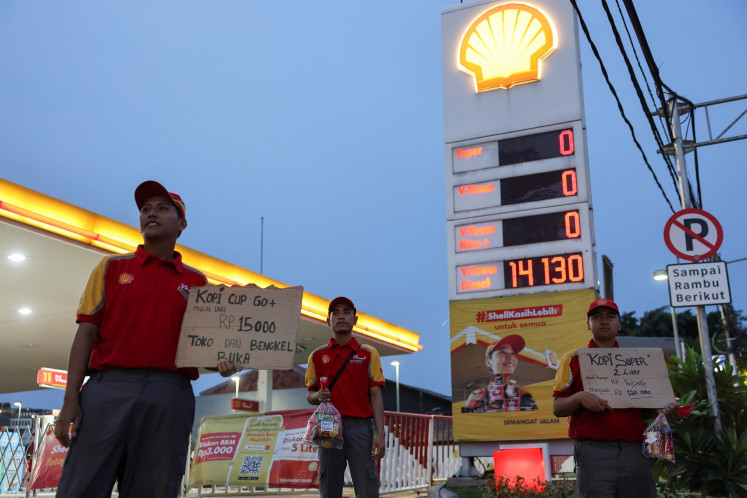Popular Reads
Top Results
Can't find what you're looking for?
View all search resultsPopular Reads
Top Results
Can't find what you're looking for?
View all search resultsAiming for energy resilience, decarbonization through grid interconnections
Change text size
Gift Premium Articles
to Anyone
I
n a country as large and as populous as Indonesia, electricity is both a necessity and a luxury. From the bright neon lights of its metropolises to the starlit skies of remote villages, a little bit of light goes a very long way.
Even so, the global push for sustainability has pushed renewed focus on the potential of renewable energy for every conceivable purpose, including powering nations around the globe. Taking into account Indonesia’s varied distribution and availability of power grids, what does it mean for the country’s future?
Speaking at an HK ExperTalk webinar on January 26th, Director of Electricity Program Development Jisman Hutajulu, Ministry of Energy and Mineral Resources explained that the electricity program should take into account the “5K” of “kecukupan, keandalan, keberlanjutan, keterjangkauan dan keadilan” (sufficiency, reliability, sustainability, affordability and fairness).
“Sufficiency” covers the electricity needs of the entire nation, from supply and demand to surplus energy. At the same time, the electricity supply must be reliable enough to avoid blackouts, sustainable enough to comply with the 2015 Paris Agreement, affordable enough for the general public and widespread enough to cover frontier, outermost and least developed (3Ts) regions.
According to Jisman, the government is currently preparing to shift from fossil fuels to renewable energy while also planning to install interconnected power grids on major islands. Even so, greater focus on renewable energy is needed if Indonesia is aligned with the Paris Agreement.
Jisman also noted the large, untapped potential of renewable energy sources in Indonesia. With a potential capacity of approximately 3,686 gigawatts (GW), only 10 GW was used
While the country has abundant renewable energy resources, its variable or intermittent nature produces unique challenges, particularly in maintaining constant balance between energy supply and demand required for a stable electric power grid.
The intermittent nature of renewable energy, along with the lack of its connectivity to the nation’s main power grid are proven to be a challenge. Transmission is an essential component of facilitating the widescale adoption of renewable energy
The Nusantara Super Grid is an inter-island electricity interconnection that is expected to boost renewable energy development while keeping the energy system reliable and secure. The transmission system will allow Indonesia to import and export renewable energy-based electricity to neighboring countries, like Singapore and Malaysia. According to Jisman, several inter-island electricity connections are planned, including the Sumatra-Malaysia interconnection which is part of the ASEAN Power Grid with expected commercial operation date in 2030.
Novias Nurendra, Operations Director, PT Hutama Karya stated the importance of Asean Power Grid interconnection not only to help increase the use of renewable energy in the region but also provide an opportunity for Indonesia to become the producer of renewable-energy based electricity for the region as the country has the largest renewable energy sources.
Shanthakumar M.S., Head of HVDC Technology, Grid Integration of Hitachi Energy India, observed that grid interconnectivity is the way forward for Indonesia as the country is in the process of energy transformation while increasing renewable integration and reduction of carbon footprint.
For Indonesia, it is important to expand the capacity of existing grid interconnections and add new connections to integrate isolated electricity systems and remote renewable sources to deliver a broad range of social, environmental and economic values.
He further mentioned that interconnected power systems and cross-border electricity trade provide great opportunities for Indonesia to deploy large amounts of variable renewables and at the same time address the related grid stability and power quality issues. In addition to grid interconnectivity, combined with energy storage solutions will provide more flexibility, scalability and energy balance to the grid
“Advances in electricity transmission technology will allow us to connect the high quality renewable energy sources,” said Shantakumar. “Today, high-voltage alternating current (HVAC) and high-voltage direct current (HVDC) transmission solutions are being used to interconnect electricity grids and remote renewable integration.”
According to Shantakumar, HVDC technology is a key enabler for a carbon-neutral energy system and is the preferred solution because it provides more benefits, such as more power transmission within less space (ROW), controlled power flow, grid stability support and more environmentally sustainable.
“We will have growing demand for electricity, not just in Indonesia region, but also around the world. We believe that [Indonesia] possesses a vast amount of renewable energy sources and set an ambitious target for carbon footprint reduction. There is tremendous potential and opportunities in terms of renewable integration, grid interconnection and energy storage solutions,” Shanthakumar concluded.
This article is a joint collaboration with The Jakarta Post and Hitachi Energy.











